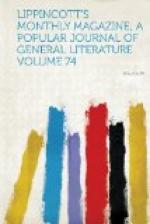In the year 1540, Francisco Vasquez de Coronado was sent by the Spanish viceroy of Mexico to explore the regions to the north. Those mountain-peaks, dim and shadowy in the distance and seeming to recede as they were approached, had ever been an alluring sight to the gold-seeking Spaniards. But the coveted treasure did not reveal itself to their cursory search; and though they doubtless pushed as far north as the Arkansas River, they returned to the capital from what they considered an unsuccessful expedition. The way was opened, however, and in 1595 the Spaniards came to what is now the Territory of New Mexico and founded the city of Santa Fe. They had found, for the most part, a settled country, the inhabitants living in densely-populated villages, or pueblos, and evincing a rather high degree of civilization. Their dwellings of mud bricks, or adobes, were all built upon a single plan, and consisted of a square or rectangular fort-like structure enclosing an open space. Herds of sheep and goats grazed upon the hillsides, while the bottom-lands were planted with corn and barley. Thus lived and flourished the Pueblo Indians, a race the origin of which lies in obscurity, but connected with which are many legends of absorbing interest. All their traditions point to Montezuma as the founder and leader of their race, and likewise to their descent from the Aztecs. But their glory departed with the coming of Cortez, and their Spanish conquerors treated them as an inferior race. Revolting against their oppressors in 1680, they were reconquered thirteen years later, though subsequently allowed greater liberty. By the treaty of Guadalupe-Hidalgo in 1848 they became citizens of the United States. From one extreme of government to another has drifted this remnant of a stately race, till now at last it finds itself safely sheltered in the arms of our great republic.
Such is the romantic history of a portion of our so-called “New West;” but it was with a view of ascertaining some facts concerning occurrences of more recent date, as well as of seeing some of the actors therein, that we paid a visit to Pueblo. We found it a rather odd mixture of the old and the new, the adobe and the “dug-out” looking across the street upon the imposing structure of brick or the often gaudily-painted frame cottage. It looked as though it might have been indulging in a Rip Van Winkle sleep, except that the duration might have been a century or two. High mesas with gracefully rounded and convoluted sides almost entirely surround it, and rising above their floor-like tops, and in fine contrast with their sombre brown tints, appear the blue outlines of the distant mountains. Pike’s Peak, fifty miles to the north, and the Spanish Peaks, the Wawatoyas, ninety to the south, are sublime objects of which the eye never grows weary; while the Sierra Mojadas bank up the western horizon with a frowning mountain-wall. A notch in the distant range, forty miles to the north-west, indicates the place where the Arkansas River breaks through the barriers that would impede its seaward course, forming perhaps the grandest canon to be found in all this mighty mountain-wilderness. Truly a striking picture was that on which Coronado and his mail-clad warriors gazed.




